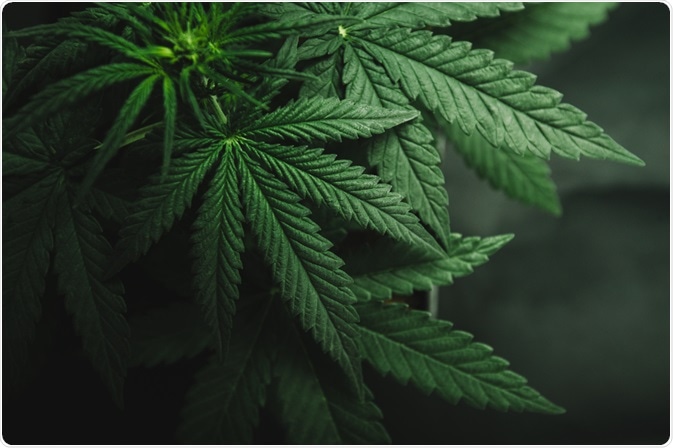The detection of cannabis in the body is not only of interest for criminal investigations but is also critical for researchers interested in elucidating the kinetics of this plant’s compounds after its use.

Image Credit: Yarygin/Shutterstock.com
Importance of detecting cannabis
There is a wide range of scenarios in which the measurement of cannabinoids in the body is necessary, some of which include:
Regardless of the scenario, the increasing legalization and subsequent widespread use of cannabis have caused a more urgent need than ever for researchers to develop a wide range of efficient cannabis detection methods.
A wide range of analytical techniques has been used to measure the presence of cannabinoids in saliva, blood, urine, hair, and nails, some of which include immunoassays and chromatographic techniques.
Blood analysis
The primary psychoactive ingredient in cannabis is delta-9-tetrahydrocannabinol (THC). This highly lipid-soluble compound can exert its effects on individuals as a result of either smoking or oral ingestion.
Upon smoking, THC is rapidly absorbed by the lungs, which allows for this compound to quickly enter the blood circulation and distribute itself to various tissues in the body that have a high lipid content, some of which include the brain, muscle, and fat.
Typically, concentrations of THC will rapidly rise after smoking, peak within an hour to a concentration of approximately 2 ng/ml and ultimately fall rapidly as THC is redistributed throughout the body.
Several attempts have been made to identify cannabinoids and their relevant metabolites in the serum, plasma, and whole blood.
One of the first attempts to characterize free THC, as well as the other prevalent cannabinoids of cannabidiol (CBD) and cannabinol (CBN) in both whole-blood and plasma samples was achieved by liquid chromatography coupled with tandem mass spectrometry (LC-MS/MS).
This method involves the initial precipitation of proteins present within the whole blood and plasma by the addition of acetonitrile.
Once protein precipitation has been completed, samples are centrifuged and the supernatant is collected, diluted and subjected to solid-phase extraction. All extracts were then chromatographed by LC-MS/MS.
This analytical method was found to not only identify the minor cannabinoids of CBD and CBN but also assisted the researchers in gaining a better understanding of the pharmacokinetic activity of cannabis after it is smoked.
Urinalysis
The preferred sampling media for measuring cannabinoid concentration is the urine due to its ease of sampling, as well as the higher concentration and longer detection time of metabolites that may be present in this bodily fluid.
On average, the half-life of cannabis in humans is 67 days; however, for chronic users, a positive test result does not necessarily indicate whether the presence of cannabis is due to a recent episode of drug use or the continued excretion of residual drug.
Some of the most common cannabinoids that can be measured in urine include THC, CBD, and CBN, as well as the two major metabolites of THC, of which include 11-nor-9-carboxy-THC (COOH-THC) and 11-hydroxy-THC (OH-THC).
Immunoassays were heavily relied upon during the early stages of cannabis testing; however, the frequent occurrence of both false-negative and false-positive results greatly limited its use for cannabis detection alone.
To this end, several chromatographic techniques like gas chromatography combined with mass spectrometry (GC-MS) were coupled with immunoassays to confirm any positive results.
More recently, ultrahigh performance liquid chromatography coupled with tandem mass spectrometry (UHPLC-MS/MS) has been validated as a multifunctional method for the determination of THC, CBD, CBN, COOH-THC, and OH-THC.
Oral fluid
One of the greatest concerns that forensic scientists and law officials are facing as a result of the widespread legalization of marijuana is how to ensure that cannabis users will not be driving when they are under the effects of the drug.
Despite the sensitivity, accuracy, and reliability of both urine and blood tests for the measurement of cannabinoids and its metabolites, this type of sample collection requires much more time and sample preparation, thereby limiting its effectiveness when immediate results are required, such as in driving under the influence (DUI) cases.
Therefore, the testing of oral fluid is an ideal choice, as law enforcement officers can easily collect this fluid at the roadside to determine cannabis concentrations immediately at the moment of the suspected offense.
To date, there are no standardized collection devices that have been established to measure cannabinoid concentrations within the oral fluid. One of the biggest challenges facing researchers includes the limited stability of cannabinoid compounds, as well as the dry mouth effect that is commonly experienced following cannabis use that reduces the amount of oral fluid available for testing.
It is important to note that, regardless of the fluid being tested, there is a little to no research available that would provide the minimum concentration of cannabinoids present within a given matrix that will undoubtedly result in impaired driving.
Although the research on this subject is still inconclusive, some scientific studies have confirmed that the presence of several cannabinoids, some of which include THC, BD, CBN, cannabigerol (CBG), 9-tetrahydrocannabinolic acid (THCA-A_ and tetrahydrocannabivarin (THCV) is associated with impaired driving capabilities.
Sources
- Odell, M. S., Frei, M. Y., Gerostamoulos, D., Chu, M., & Lubman, D. I. (2015). Residual cannabis levels in blood, urine and oral fluid following heavy cannabis use. Forensic Science International 249; 173-180. DOI: 10.1016/j.forsciint.2015.01.026.
- Sharma, P., Murthy, P., & Bharath, M. M. S. (2012). Chemistry, Metabolism, and Toxicology of Cannabis: Clinical Implications. Iranian Journal of Psychiatry 7(4); 149-156. PMCID: PMC3570572.
- Wei, B., Wang, L., & Blount, B. C. (2015). Analysis of Cannabinoids and Their Metabolites in Human Urine. Analytical Chemistry 87(20); 10183-10187. DOI: 10.1021/acs.analchem.5b02603.
- Schwope, D. M., Karschner, E. L., Gorelick, D. A., & Huestis, M. A. (2011). Clinical Chemistry 57(10); 1406-1414. DOI: 10.1373/clinchem.2011.171777.
- Sobolesky, P. (2018). Testing for Cannabis in Oral Fluid: The State of the Art. American Association for Clinical Chemistry.
Further Reading
Last Updated: Apr 1, 2020